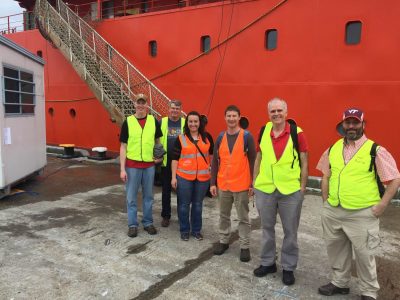Making Plans for MARCUS
Published: 9 May 2017

Editor’s note: Greg McFarquhar, a professor of atmospheric sciences at the University of Illinois at Urbana-Champaign and principal investigator (PI) for the Measurements of Aerosols, Radiation, and Clouds over the Southern Ocean (MARCUS) campaign, sent this update.
I recently visited the Aurora Australis supply vessel with fellow MARCUS PIs Roj Marchand from the University of Washington and Simon Alexander of the Australian Antarctic Division (AAD). During MARCUS, the ship will travel between Hobart, Australia, and the Antarctic while the second ARM Mobile Facility (AMF2) collects data on board. Scott McClain, Cory Wolff, and Chrissy Fladung of the National Center for Atmospheric Research joined us during a site survey for the Southern Ocean Clouds, Radiation, Aerosol Transport Experimental Study (SOCRATES), which is a companion project to MARCUS.
Along with discussing preparations for MARCUS with AAD personnel, Roj, Simon, and I examined the proposed locations of the probes to be used during the field campaign on the Aurora Australis. We confirmed that most of the locations worked very well, but we also identified a couple of shadowing problems on the radiometers and a potential blockage of the micropulse lidar that might require small changes to the proposed arrangement.
After returning from Australia, I talked about our site visit during a breakout session I led at the 2017 Joint User Facility/Principal Investigator Meeting in Virginia. I discussed various issues related to data availability from the ship, potential effects of sea spray on the instruments, and strategies for conducting related modeling studies. The technicians will work to keep the instruments clean during MARCUS and upload some data during the cruises so that the investigators can have a good first look at the datastreams.
We’ll cross our fingers that everything goes smoothly, but we will be prepared.
The ARM Climate Research Facility is a DOE Office of Science user facility. The ARM Facility is operated by nine DOE national laboratories, including .
Keep up with the Atmospheric Observer
Updates on ARM news, events, and opportunities delivered to your inbox
ARM User Profile
ARM welcomes users from all institutions and nations. A free ARM user account is needed to access ARM data.


















